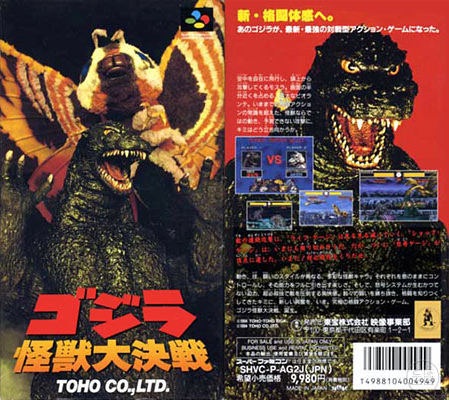Godzilla: Great Monster Battle: Difference between revisions
No edit summary |
(→Stages) |
||
| Line 48: | Line 48: | ||
*[[Battra]] (Mothra's special combo move only) | *[[Battra]] (Mothra's special combo move only) | ||
==Stages== | ==Stages== | ||
*[[Osaka Castle]] Grounds | *[[Osaka Castle]] Grounds (大阪城周辺) | ||
*[[Mount Fuji|Fuji]] Five Lakes | *[[Mount Fuji|Fuji]] Five Lakes (富士五湖) | ||
*World Children's Land | *World Children's Land (世界子供ランド) | ||
*Outskirts Of [[Tokyo]] | *Outskirts Of [[Tokyo]] (東京近郊) | ||
*Yokosuka | *Yokosuka (横須賀) | ||
*Wakasa Bay | *Wakasa Bay (若狭湾) | ||
*Minato Mirai 21 | *Minato Mirai 21 (みなとみらい 21) | ||
*Makuhari Bay Area | *Makuhari Bay Area (幕張ベイエリア) | ||
*[[Tokyo Bay]] | *[[Tokyo Bay]] (東京湾) | ||
==Gallery== | ==Gallery== | ||
<gallery widths='120' position='center' captionalign='center' spacing='small'> | <gallery widths='120' position='center' captionalign='center' spacing='small'> | ||
Revision as of 09:04, 28 August 2018
| Alfa System Godzilla Games | |||||||
|
|
| |||||
| |||||||||||||||||||||||||||||||||||||||||||||||
Godzilla: Great Monster Battle (ゴジラ怪獣大決戦 Gojira Kaijū Daikessen) is a 2-D fighting game developed by Alfa System and published by Toho for the Super Famicom, released on December 9, 1994. It is the sequel to Godzilla: Battle Legends. An American version of the game called Godzilla: Destroy All Monsters was planned to be released in April 1995, but never was.
Gameplay
Single Player
In the single player game, players are able to choose from Godzilla himself, Anguirus, King Ghidorah, Gigan, Megalon, Mechagodzilla, Biollante and Mothra. After selecting a monster, the player is taken to a map of Japan and must select an opponent to battle. Battles take place in the familiar 2D fighting screen popularized by Street Fighter 2, though the game plays more akin to the SNES Dragon Ball Z fighting games. Each round has a time period of sixty seconds during which each monster fights with a variety of attacks to wear their opponent's energy bar down and win the round. At the end of the round, the player's score is tallied up based on time, energy, and the level of their opponent. Once every enemy monster has been defeated, the player enters the eighth, final round and must face the Heisei Mechagodzilla or the Gotengo. Upon the defeat of one of those opponents, the credits roll and the game ends.
Each monster has a variety of standard and unique, special attacks and the ability to block. Standard attacks include light and heavy physical attacks (punch, kick, etc.) and varying degrees of energy-based attacks, a dash attack and a grab attack. Each monster also appears to have the ability to stun the opponent with a loud roar. As a succession of hits is landed, the monster will glow red, allowing a powerful super move to be unleashed. Monsters are able to use their projectile attacks to block oncoming projectiles, similar to Street Fighter 2, and sometimes the two clash in a brief test-of-strength encounter.
Multi-Player
The game supports the standard two player Vs Mode, the only difference being the player's ability to select to play as the Heisei Mechagodzilla, Super Mechagodzilla and the Gotengo, and to choose their own battleground.
Monsters
- Godzilla
- Anguirus
- King Ghidorah
- Gigan
- Megalon
- Mechagodzilla (Showa)
- Biollante
- Mothra
- Mechagodzilla (Heisei)
- Super Mechagodzilla
- Garuda (can attach to or detach from Super Mechagodzilla)
- Gotengo
- Battra (Mothra's special combo move only)
Stages
- Osaka Castle Grounds (大阪城周辺)
- Fuji Five Lakes (富士五湖)
- World Children's Land (世界子供ランド)
- Outskirts Of Tokyo (東京近郊)
- Yokosuka (横須賀)
- Wakasa Bay (若狭湾)
- Minato Mirai 21 (みなとみらい 21)
- Makuhari Bay Area (幕張ベイエリア)
- Tokyo Bay (東京湾)
Gallery
King Ghidorah's palette swaps
Videos
- Main article: Godzilla: Great Monster Battle/Videos.
Trivia
- Despite not being playable in this game after being playable in Godzilla: Battle Legends, Battra appears as a special move used by Mothra, replicating a scene from Godzilla vs. Mothra.
- The Showa and Heisei Mechagodzillas are both only referred to as "メカゴジラ" (Mekagojira) in this game, the only difference being the font in which their names are displayed and the subtitles displayed above them. The Showa Mechagodzilla's name is written in the same font it appeared in on posters for Godzilla vs. Mechagodzilla, while the Heisei Mechagodzilla's name is written in the font used on posters for Godzilla vs. Mechagodzilla II. The Showa Mechagodzilla is given the subtitle "Robot Monster," while the Heisei incarnation is given the subtitle "G-Force Anti-Godzilla Weapon."
- The May 1995 issue of the magazine Nintendo Power mentioned an American release of this game, titled Godzilla: Destroy All Monsters, and claimed that it was released in April, though it never was. The game was never mentioned in the magazine again, and never saw an American release, probably due to the impending production and release of the first Nintendo 64s.








